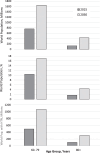Managing Hypertension in Older Adults
- PMID: 38150080
- PMCID: PMC10904451
- DOI: 10.1007/s11906-023-01289-7
Managing Hypertension in Older Adults
Abstract
Purpose of review: The population of older adults 60-79 years globally is projected to double from 800 million to 1.6 billion between 2015 and 2050, while adults ≥ 80 years were forecast to more than triple from 125 to 430 million. The risk for cardiovascular events doubles with each decade of aging and each 20 mmHg increase of systolic blood pressure. Thus, successful management of hypertension in older adults is critical in mitigating the projected global health and economic burden of cardiovascular disease.
Recent findings: Women live longer than men, yet with aging systolic blood pressure and prevalent hypertension increase more, and hypertension control decreases more than in men, i.e., hypertension in older adults is disproportionately a women's health issue. Among older adults who are healthy to mildly frail, the absolute benefit of hypertension control, including more intensive control, on cardiovascular events is greater in adults ≥ 80 than 60-79 years old. The absolute rate of serious adverse events during antihypertensive therapy is greater in adults ≥ 80 years older than 60-79 years, yet the excess adverse event rate with intensive versus standard care is only moderately increased. Among adults ≥ 80 years, benefits of more intensive therapy appear non-existent to reversed with moderate to marked frailty and when cognitive function is less than roughly the twenty-fifth percentile. Accordingly, assessment of functional and cognitive status is important in setting blood pressure targets in older adults. Given substantial absolute cardiovascular benefits of more intensive antihypertensive therapy in independent-living older adults, this group merits shared-decision making for hypertension targets.
Keywords: Antihypertensive medications; Cardiovascular events; Hypertension; Isolated systolic hypertension; Lifestyle change; Older adults.
© 2023. The Author(s).
Conflict of interest statement
BME has received royalties from UpToDate for hypertension-related topics including “Treatment of hypertension in older adults, particularly isolated systolic hypertension”. He has received consulting fees for participation on a Data Safety Monitoring Board on an NIH-funded study through the Clinical Directors Network. HJMK has received consulting fees from Bayer and Vifor as well as honoraria for lectures from the Academy of Nutrition and Dietetics. JNB has received grant funding from Ablative Solutions and Recor Medical and consulting fees from Eli Lilly and Recor. SES owns stock in Merck, Novartis, and Pfizer.
Figures




References
-
- United Nations, Department of Economic and Social Affairs, Population Division (2015). World Population Prospects: The 2015 Revision, Key Findings and Advance Tables. Working Paper No. ESA/P/WP.241United Nations (2015). World Population Prospects: The 2015 Revision.
-
- The prevalence of high blood pressure among U.S. adults by age and sex. (Source: Heart Disease and Stroke Statistics–2020 Update: A report from the American Heart Association).
-
- Lewington S, Clarke R, Qizilbash N, Peto R, Collins R; Prospective Studies Collaboration. Age-specific relevance of usual blood pressure to vascular mortality: a meta-analysis of individual data for one million adults in 61 prospective studies. Lancet. 2002;14;360(9349):1903–13. - PubMed
Publication types
MeSH terms
Substances
LinkOut - more resources
Full Text Sources
Medical
Research Materials

